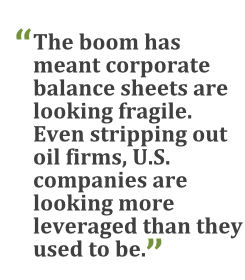Pop quiz: Which corporate debt has performed better thisyear—the U.S. dollar-denominated bonds issued by Russiancompanies or investment-grade U.S. corporates?
|If you answered Russian ones, well done. For all the talk ofRussia's economic woes, it's actually the bonds issued by some ofAmerica's most creditworthy companies that have lost ground sofar in 2015. In fact, prices on U.S. investment-grade bonds fell1.1 percent alone in the first two days of June. Why the (rathersudden) lack of love for what was once one of the hottest assetclasses around?
|Deutsche Bank strategists Oleg Melentyev and Daniel Sorid havesome thoughts.
| Inshort, they figure that investors may (finally) be turning againstan asset class which has been booming in recent years. DeutscheBank notes retail money has been pouring intointermediate and long-term investment-grade mutual fundsat a rate of 20 percent or more per year. The size of theoverall corporate bond market has exploded fromUS$5.4 trillion back in 2009 to $7.8 trillion currently ascompanies rush to take advantage of ultra-low borrowing costs andinvestors keen to buy their debt.
Inshort, they figure that investors may (finally) be turning againstan asset class which has been booming in recent years. DeutscheBank notes retail money has been pouring intointermediate and long-term investment-grade mutual fundsat a rate of 20 percent or more per year. The size of theoverall corporate bond market has exploded fromUS$5.4 trillion back in 2009 to $7.8 trillion currently ascompanies rush to take advantage of ultra-low borrowing costs andinvestors keen to buy their debt.
That dynamic has helped fuel a buyback boom and corporateearnings per share, which may otherwise have been stagnant in alackluster economic environment.
|The boom has also meant corporate balance sheets are lookingeven more fragile. Even stripping out oil firms, which haveseen their debt to earnings ratio rise thanks to falling crudeprices, U.S. companies are looking more leveraged than they used tobe.
|And with interest rates in the U.S. expected to move up sometime thisyear, it may be that investors are finally starting toconsider fundamentals when they look at investment-gradecorporate debt.
|Here's what the Deutsche strategists say:
Issuers are embracing the trend toward weaker fundamentals withboth arms. Not only are debt loads rising, but EBITDA [earningsbefore interest, taxes, depreciation and amortization] levels arealso falling, and have dropped for two consecutive quarters. Again,as Figure 2 shows, this is not merely a consequence of oil prices.A third measure of deteriorating balance sheets, interest coverage,captures the IG balance sheet deterioration best. While IG issuershave had two years of <3% IG index yields to refinance legacydebt issued in an environment of >5% overall IG yields, issuershave actually lost ground in their ability to cover interestexpenses with EBITDA. Interest coverage, as shown in Figure 3, isas weak as it's been since 2009, and lower than pre-crisis levels.Again, the energy sector is not the only culprit.
Weak global growth and a low interest rate environment play animportant role in understanding how balance sheets got towhere they are. Issuer debt loads, even on a net basis, havebeen growing at an annual rate of roughly 10 percent ascompanies take advantage of cheaper borrowing costs to financeacquisitions or repurchase stock to support EPS [earnings pershare]. With end demand still tepid globally, companymanagement teams can crank up leverage to boost return onequity. Investors, starved for yield, have been happy, thus far, toearn the greater spread compensation that comes along with greaterissuer leverage.
|As the Fed prepares the market for the end of the period of zeroshort-term rates, we may be approaching a reassessment of justhow much leverage is appropriate given the overall marketcompensation.
|One to watch.
|Copyright 2018 Bloomberg. All rightsreserved. This material may not be published, broadcast, rewritten,or redistributed.
Complete your profile to continue reading and get FREE access to Treasury & Risk, part of your ALM digital membership.
Your access to unlimited Treasury & Risk content isn’t changing.
Once you are an ALM digital member, you’ll receive:
- Critical Treasury & Risk information including in-depth analysis of treasury and finance best practices, case studies with corporate innovators, informative newsletters, educational webcasts and videos, and resources from industry leaders.
- Exclusive discounts on ALM and Treasury & Risk events.
- Access to other award-winning ALM websites including PropertyCasualty360.com and Law.com.
*May exclude premium content
Already have an account? Sign In
© 2024 ALM Global, LLC, All Rights Reserved. Request academic re-use from www.copyright.com. All other uses, submit a request to [email protected]. For more information visit Asset & Logo Licensing.







